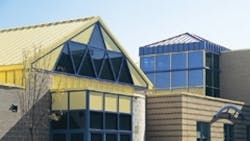In the many years since schools and universities began to put greater focus on the mountain of deferred maintenance that was exacerbating the deterioration of education facilities, prevention has become the watchword for those responsible for keeping school buildings working properly.
Preventive maintenance—monitoring the conditions and performance of a facility so that potential problems can be discovered and corrected before they become costly repair jobs—is considered an essential practice in making sure school buildings don’t wear out prematurely.
That is especially true for roofs, according to the Colorado Department of Education’s "Guide to Maximizing the Life of your Roof through Preventive Roof Maintenance."
Leaks that go undetected may result in catastrophic damage, the guide says. A program that emphasizes prevention gives schools and universities a better chance to fix a roof before a leak threatens an institution’s investment, not to mention the health and safety of students and staff.
The obstacle that many education administrators have to overcome before a preventive maintenance program can be established is that budget restraints and the conflicting priorities schools have to address don’t always enable maintenance managers to have a long-term perspective. Deferring roof maintenance may be easier than putting off other facility needs because roof conditions—good or bad—are not visible to most people.
The Colorado guide recommends these strategies in putting a preventive roof maintenance program into place:
•Database. When a roof is first installed, school administrators should make sure they are provided with data about the project, including the specifications, where penetrations and equipment are situated on the roof, and manufacturer or contractor warranties.
•Surveys. In general, schools should conduct comprehensive visual surveys of roofs twice a year—in the spring and fall. The survey should include a written report, photographs and notations on a roof plan indicating the conditions observed. In some cases, for example, "large roof areas in good condition with limited roof-top traffic," having only one comprehensive, visual survey a year may be sufficient.
Other types of roof surveys a school should carry out: a survey prior to the expiration of a roof warranty; conducting a housekeeping survey once a month enables schools to keep drains from becoming clogged; and roof moisture surveys should be carried out every three years, unless there is reason to believe moisture is a problem.
Schools should have comprehensive visual surveys done by those with technical knowledge of design and installation of roof systems. A staff member may have that expertise, or the school may have to bring in a consultant. In-house maintenance workers should be able to conduct housekeeping surveys and carry out minor repairs.
Roof inspectors should be on the lookout for several potential problems, the Ohio Department of Health says:
•Standing water on ground adjacent to storm drains, or standing water or evidence of past standing water on roof deck.
•Gutters, downspouts or storm drains blocked with debris.
•Cracks, gaps or other damage to gutters, downspouts or storm drains.
•Accumulation of excessive debris on roof deck.
•Suspected microbial growth or other water damage on roof deck.
•Evidence of bird, rodent or insect infestation.
•Cracked, damaged or missing roof deck material, or cracked or broken roof deck seals. Cracks, gaps or other damage to walls.
•Improperly sealed flashing systems.
•Suspected microbial growth on rooftop surfaces.
•Other conditions that may result in water intrusion into the building.
•Suspected microbial growth on HVAC system components.
•Air contaminant sources near outside air intakes to air-handling units.
•Blocked, obstructed or broken outside air intakes.
•Broken or missing air-intake screens on air handling units
•Excessive noise generated by HVAC system components.
Kennedy, staff writer, can be reached at [email protected].
Related Stories
About the Author
Mike Kennedy
Senior Editor
Mike Kennedy, senior editor, has written for AS&U on a wide range of educational issues since 1999.
